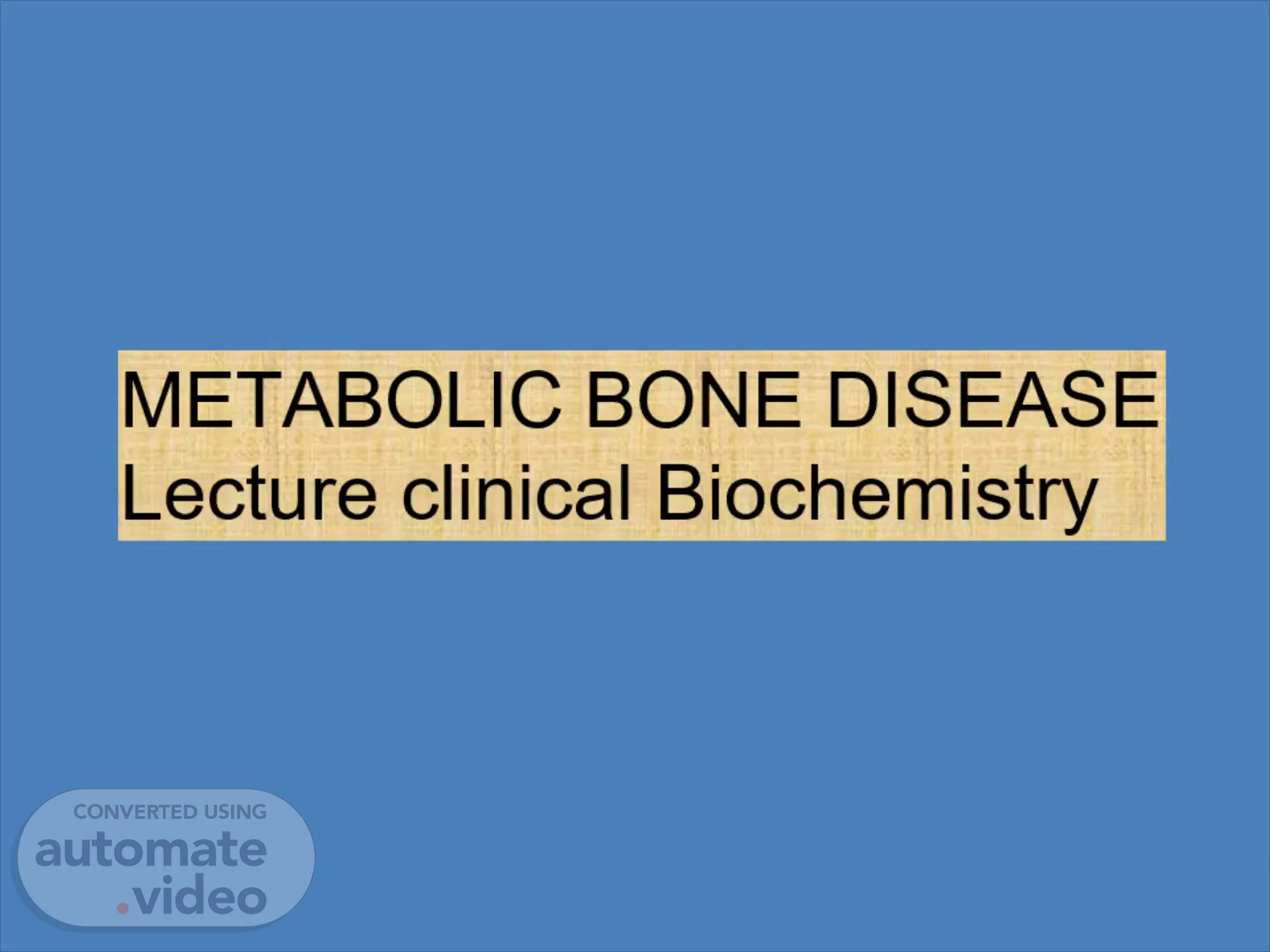
Page 1 (0s)
METABOLIC BONE DISEASE Lecture clinical Biochemistry.
Page 2 (6s)
Composition of Bone. The extracellular matrix 40% organic Type 1 collagen Proteoglycan Osteocalcin/osteonectin Growth factors/cytokines 60% inorganic Calcium hydroxyapatite Ca 10 (PO 4 ) 6 (OH) 2 The cells Osteo-clast/blast/cytes/progenitors.
Page 3 (19s)
Bone Turn over.
Page 4 (25s)
Calcium metabolism. What is recommended daily intake? Adult: 1000 mg/day Pregnancy,lactation,postmenopausal: 1.3 g/day Children (1-18 yrs): 0.5-1.3 g/day Infant (<1 yr): 300-500 mg/day What is plasma concentration? Total (mg/dL): 8.6-10.3 (mmol/L): 2.15-2.57 Ionized (mg/dL): 4.5-5.6 (mmol/L): 1.1-1.4.
Page 6 (55s)
Phosphate Metabolism. What is recommended daily intake? Infants (< 1yrs): 100-275 mg/day Children (1-18 yrs): 460-1250 mg/day Adults:700-1250 mg/day Pregnancy/lactation: 700-1250 mg/day What is plasma concentration? Adult:2.5-4.5 mg/dL Children:4-7 mg/ dL.
Page 8 (1m 19s)
Parathyroid hormone (PTH). Synthesizes and secreted by chief cells of parathyroid gland Synthesized as pre-pro-PTH, cleaved enzymatically to intact PTH Plasma calcium : primary physiological regulator of PTH synthesis and secretion Normal Reference Range: 10 -65 ng/L.
Page 9 (1m 33s)
Effect on serum levels: increase Ca, decrease P. Target organ Action Kidney Increase reabsorption of Ca Increase excretion of P Bone Increase Ca/P mobilization from bone GIT Increase in Ca absorption by stimulating activation of Vitamin D.
Page 10 (1m 47s)
Vitamin D. Sources of vitamin D? Diet UV light exposure on precursor in skin Daily requirement? 400 International units.
Page 11 (1m 57s)
Target organ Action Bone Increase Ca mobilisation from bone GIT Increase in Ca absorption.
Page 12 (2m 9s)
Calcitonin. Secreted by parafollicular or C cells distributed throughout thyroid gland Normal serum concentration Men :<8.8 pg/mL Women :<5.8 pg/mL Level Increases when serum Ca concentration > 2.25mmol/L.
Page 13 (2m 22s)
Effect on serum levels: decrease Ca, increase P. Target organ Action Bone Supresses resorption Kidney Increase excretion of Ca.
Page 14 (2m 33s)
Alkaline Phosphate. Present in all tissue, concentrated in liver, intestins, kidney, bone and placenta Normal range: 20 – 140 IU/L.
Page 15 (2m 44s)
Recent Markers. Osteoblasts. Osteoid. Os t eoc y t e Bone matrix.
Page 16 (3m 3s)
Disease with markers. Disease S. Ca S. PO 4 S.PTH S. ALP Recent biomarker Osteoporosis N N N N/high Cathepsin K C- telopeptide Rickets/Osetmalacia Low low high high Osteocalcin Paget’s disease N N N high --.
Page 17 (3m 16s)
Metabolic bone diseases. heterogeneous group of disorders characterized by abnormalities in calciummetabolism and/or bone cell physiology. They lead to analtered serum calcium concentration and/or skeletal failure. The most common type of metabolic bone disease in developed countries is osteoporosis Osteoporosis Osteomalacia & Rickets Renal Osteodystrophy.
Page 18 (3m 31s)
Rickets & Osteomalacia. Rickets is defective mineralization of bones before epiphysial closure in immature mammals due to deficiency or impaired metabolism of vitamin D, phosphorus or calcium ,potentially leading to fractures and deformity. Osteomalacia is a similar condition occurring in adults, generally due to a deficiency of vitamin D but occurs after epiphyseal closure..
Page 19 (3m 48s)
Rickets & Osteomalacia. Vit D deficiency low intake plus inadequate sunlight exposure malabsorption Abnormal vit D metabolism Liver disease Renal disease Drugs(anticonvulsants) Hypophosphatemia Low intake Hypophosphatemic Vitamin D resistant rickets(X-linked ).
Page 20 (3m 59s)
Skeletal deformity Toddlers: Bowed legs ( genu varum ) Older children: Knock-knees ( genu valgum ) or "windswept knees" Cranial deformity (such as skull bossing or delayed fontanelle closure) Pelvic deformity Spinal deformity (such as kyphoscoliosis or lumbar lordosis ).
Page 26 (4m 39s)
Rickets & Osteomalacia. Lab investigations include : S. ALP ↑ Ca low in Vitamin D deficiency Phosphate may be normal or low PTH may ↑.
Page 27 (4m 49s)
OSTEOPOROSIS. Common in developed countries Associated with advanced age Associated with increased risk of fractures (hip, vertebrae, forearm) Exercise & nutrition play an important role in attaining adequate skeletal mass During early adult life bone formation = bone resorption Aging increases bone resorption.
Page 29 (5m 9s)
OSTEOPOROSIS. Pathophysiology Inadequate bone formation during growth Pathophysiological process impairing osteoblastic bone formation Increase in bone resorption.
Page 30 (5m 18s)
Factors involved in causation of osteoporosis. Hormones Poor diet Genetic factors Cytokines Prostaglandins Growth factors Low physical activity and low exposure to sunlight.
Page 31 (5m 28s)
O s t eoporosis. Risk Factors Early menopause family history Sedentary life Low calcium intake Cigarette smoking Excessive alcohol Excessive caffeine steroid therapy.
Page 32 (5m 40s)
Clinical presentations. Back pain Fractures Investigations Routine X-rays Bone scan Investigations for secondary causes.
Page 34 (5m 54s)
Osteoporosis (management). Exercise Calcium Vit D Bisphosponates Oestrogen replacement Androgens.
Page 35 (6m 1s)
Pagets Disease. Disease of bone remodelling osteoclast mediated bone resorption followed by new bone formation Cause unknown ?virus (paramyxovirus) More common in caucasian.
Page 36 (6m 11s)
Pagets Disease (clinical manifestation ). Bone pain Joint pain Deformity Spontaneous fractures.
Page 37 (6m 19s)
Pagets Disease (complications). Fractures Deafness Nerve entrapment Spinal stenosis Cardiac failure Osteogenic sarcoma Hypercalcemia.
Page 38 (6m 27s)
Pagets Disease (investigations). ↑ markers of bone formation ↑ ↑ Serum alk phosphatase Urinary hydroxy proline and pyridinoline cross links X-rays cortical thikening osteolytic, & osteiosclerotic bone scan.
Page 39 (6m 38s)
RENAL OSTEODYSTROPHY. Associated with CRF ↓excretion of PO4 > ↑ PO4 Inability of kidney to synthesise 1,25 (OH) 2 D (↓ renal mass & ↑ PO 4 ) ↓ intestinal absorption of Ca > hypocalcemia Results in hyper parathyroidism.
Page 41 (6m 56s)
RENAL OSTEODYSTROPHY : CLINICAL MENIFESTATIONS. BONE PAINS (WT BEARING) SKELETAL DEFORMITIES IN CHILD EXTRACELLULAR CALCIFICATION.
Page 42 (7m 4s)
LAB INVESTIGATIONS: ↑ PO4 HYPOCALCEMIA ↑ PTH ↓ 1,25 (OH)2 D ↑ ALP Mg ↑.
Page 43 (7m 12s)
Ref : Harrison’s 18 th edition.